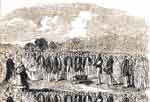Colombo Academy becomes Royal College
To go back to the early days, the various Christian missionary societies began establishing schools from around 1820. Rev. Joseph Marsh, who arrived from Madras in 1831, started a private school "for the sons of the upper classes" after his appointment as Chaplain of St. Paul's, Pettah. When the leading citizens of Colombo petitioned the Governor, Sir Robert Wilmot Horton, for Government support for the school, it was taken over and became the Colombo Academy in January 1836 with Mr. Marsh as the Principal. The school was intended to train local boys for lower level positions in the administration including those of translators and interpreters. The school moved from San Sebastian to Thurstan Road in 1913 and when those premises were taken over for the University College in 1923, it went into occupation of the present buildings at Reid Avenue. Over the years, the school developed to become the leading public sector boys' school in Colombo. It boasts of producing at least one President (J. R. Jayewardene) and two Prime Ministers (Sir John Kotelawala and Ranil Wickremasinghe), in addition to a host of politicians, professionals and academics.
Work begins on the railway On August 3, 1858 the first sod was cut to inaugurate the railway in this country. The first line to be constructed was the Colombo-Kandy railway.
An earlier suggestion to construct a railway was abandoned in 1847 due to the depression and a financial crisis in England. In 1855 Governor Sir Henry Ward made a case that a railway was "an absolute and imperative necessity" or Ceylon would "cease to exist as a coffee producing colony" due to Brazilian and Javanese competition. In February 1855 the planters, at a meeting held in Kandy, suggested that the export duty on coffee be re-imposed to finance the proposed railway. In July 1855, the Legislative Council unanimously agreed to the Governor's proposal that the Government should guarantee the interest of a loan of £ 800,000 to the Ceylon Railway Company, a private company floated in London. Work started in 1858 with Governor Ward cutting the first sod of the Colombo terminal amidst much pomp and ceremony.
The oldest government department The Survey Department established on August 2, 1800 is the oldest government department in Sri Lanka. It was created by a Proclamation of Governor Frederick North. The first Surveyor-General (head of the department), Joseph Jonville served from 1800-05. The Department launched on a project to carry out a topographical survey of the island by the turn of the century. This led to the production of the 'one inch to one mile' series of maps which covered the entire country. The project was completed in 1924. As years passed, the Department changed its programme from surveys for land sales to surveys for land development and alienation. Surveys for major irrigation schemes, land reforms, Mahaweli development and 'land for the landless' were some of the major projects under taken by the Department after Independence in 1948. Keeping pace with modern technology, the Department is equipped to carry out aerial surveys, remote sensing, cartography and map printing. The National Atlas produced in 1988 was just one example of the high quality of cartography and map printing achieved by the Survey Department.
|
|||||
Copyright © 2006 Wijeya Newspapers
Ltd. All rights reserved. |
 It
was on August 1, 1881 that Colombo Academy, the first government-run
secondary boy's school started by the British colonial administration,
was named Royal College.
It
was on August 1, 1881 that Colombo Academy, the first government-run
secondary boy's school started by the British colonial administration,
was named Royal College.